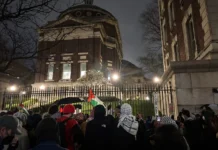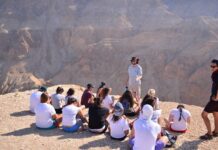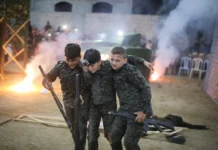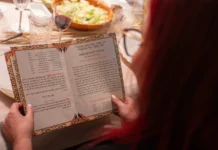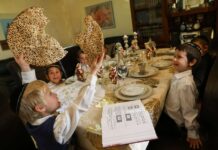There is nothing out of the ordinary in seeing Rabbi Gary Gans or Cantor Neil Schnitzer standing in front of people who have Seder plates and Haggadot at their tables. Gans, rabbi emeritus at Cong. Beth Tikvah in Marlton, led the Seder, explaining the significance of various items as well as touching on the Passover traditions and history, while Schnitzer, of Temple Emanuel in Cherry Hill, led people in the Seder’s songs and blessings.
What was out of the ordinary for those learning about the Four Questions, the 10 Plagues, and the Cup of Elijah were the location and the audience. The Seder was held at Saint Simon Stock Parish in Berlin. The audience of approximately 100 was majority Catholic. The event was sponsored by the Catholic Jewish Commission and the Jewish Community Relations Council (JCRC).
 At the Interfaith Seder were (front, from left), Hank Maurer, copresident of the Catholic Jewish Commission (CJC); Pat Sandrow, CJC co-president; Rev. Joseph Wallace, director of Ecumenical and Interreligious Affairs for the Diocese of Camden; and Rabbi Gary Gans, rabbi emeritus of Cong. Beth Tikvah in Marlton; with (rear, from left), SueAnn Jeral, pastoral associate at Saint Simon Stock; Father Jose Manjakunnel, associate pastor at Saint Simon Stock; Father Jim Dabrowski, Saint Simon Stock’s pastor; Cantor Neil Schnitzer of Temple Emanuel; Kevin DiPietropolo, event co-chair; and Richard Selznick, event co-chair.“This is an opportunity for non-Jews to learn about our traditions and for Jews and non-Jews to get together in a setting where they can learn from each other,” said Hank Maurer, co-president of the Catholic Jewish Commission. He said that the CJC was formed in 2001 and has done a number of Interfaith Seders over the years. “It is a very fulfilling experience,” he said.
At the Interfaith Seder were (front, from left), Hank Maurer, copresident of the Catholic Jewish Commission (CJC); Pat Sandrow, CJC co-president; Rev. Joseph Wallace, director of Ecumenical and Interreligious Affairs for the Diocese of Camden; and Rabbi Gary Gans, rabbi emeritus of Cong. Beth Tikvah in Marlton; with (rear, from left), SueAnn Jeral, pastoral associate at Saint Simon Stock; Father Jose Manjakunnel, associate pastor at Saint Simon Stock; Father Jim Dabrowski, Saint Simon Stock’s pastor; Cantor Neil Schnitzer of Temple Emanuel; Kevin DiPietropolo, event co-chair; and Richard Selznick, event co-chair.“This is an opportunity for non-Jews to learn about our traditions and for Jews and non-Jews to get together in a setting where they can learn from each other,” said Hank Maurer, co-president of the Catholic Jewish Commission. He said that the CJC was formed in 2001 and has done a number of Interfaith Seders over the years. “It is a very fulfilling experience,” he said.
Both Rabbi Gans and Maurer said that the Seder is a Jewish Seder. The audience is interfaith, but the content is an actual Jewish Seder complete with festive meal.
Paul and Dolores Zambito, two of the many people clapping along as Cantor Schnitzer led the “Dayenu,” were attending their first Seder. Dolores Zambito said that she had heard about Seders before, but had never been able to attend one.
Paul Zambito said that he liked the correlation between the tradition and history, “and how you’ve carried the ceremony forward from Egypt to the present day.”
Pat Sandrow, CJC co-president with Hank Maurer, said that the Interfaith Seder is a wonderful opportunity to educate Catholic people about the significance of Passover. She said that Catholics hear in church that Jesus’ last supper was a Passover Seder. “Catholics love to learn, and this is our Jewish roots and the history of our beliefs,” she said, adding, “the more we know, the more we grow.”
Rev. Joseph Wallace, director of Ecumenical and Interreligious Affairs for the Diocese of Camden, said that he was happy to have Rabbi Gans share the true meaning of the Seder and the message of freedom from slavery and God’s abiding presence. He said that it is a nice way to learn about a ritual meal sacred to Jews, one that is celebrated around the time of Easter. He said that the two holidays have “the similar themes of freedom, new life, and salvation.”
Rabbi Gans said that he really enjoys interfaith activities because of the opportunity they present to share in the commonality of community. He also said that one of his goals for the Seder was that it was educational not only for the Catholics present, but also for the Jews. He wanted to ensure that the Jews would leave “knowing more, understanding more, and bringing some of these conversations back to their own Seder tables.”

